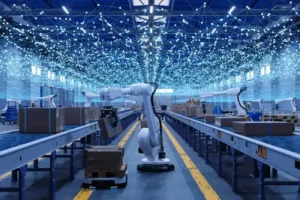Here’s a sobering reality: unexpected equipment failures bleed industrial facilities dry—we’re talking billions annually. Companies end up playing whack-a-mole with reactive repairs that cost three to five times what planned maintenance would’ve run. The old playbook of time-based maintenance (you know, checking equipment every X hours no matter what) burns through resources while somehow still missing the critical stuff that matters.
There’s a better way. Condition-based monitoring lets you track equipment health in real-time, triggering maintenance only when your data actually screams for attention. This intelligent approach to OT cybersecurity maintenance slashes downtime dramatically, cuts costs substantially, and tightens up your operational security in ways that’ll surprise you.
Understanding Condition-Based Monitoring in Industrial Settings
Modern factories operate in a different universe now. Guessing about equipment health? That’s a luxury you simply can’t afford anymore.
What Makes Condition-Based Monitoring Different
Think of condition-based monitoring as having a doctor continuously monitoring your machinery’s vital signs. Sensors track vibration, temperature, pressure—all the metrics that matter. Your maintenance crew responds to actual deterioration instead of arbitrary calendar dates.
Owens Corning’s experience tells the story perfectly. Their predictive maintenance approach prevented 5,376 hours of downtime, saving over $9.2 million in avoided production losses. That’s real money staying in the budget.
Why does this beat preventive maintenance? Simple. You catch problems while they’re tiny. You’re not tossing parts with plenty of life left, and you’re definitely not running machinery until it spectacularly fails.
The Technology Behind Real-Time Monitoring
Multiple sensor types collaborate to give you the complete health picture. Vibration analysis picks up imbalances or bearing wear before things get ugly. Thermal imaging finds electrical hotspots lurking in your systems. Oil analysis? It reveals those telltale wear particles signaling trouble ahead.
All this sensor data flows into analytics platforms that learn what “normal” looks like for your operation. When readings wander off from expected patterns, you get alerts worth investigating. Modern platforms leverage machine learning to separate genuine problems from harmless noise.
Connecting Monitoring with Security Frameworks
Your equipment monitoring doesn’t float in a vacuum—it’s woven into your operational technology network. That’s exactly why OT cybersecurity matters so much for protecting these data channels from tampering or unauthorized meddling. Weird sensor readings might mean equipment issues, sure. But they could also flag cyber intrusions trying to wreck your operations.
Integrating with industrial cybersecurity frameworks like IEC 62443 means your monitoring systems follow proper network segmentation and access protocols. You get double protection: catching mechanical failures AND spotting potential cyber threats. That strengthens your entire OT maintenance operation.
Key Benefits That Impact Your Bottom Line
Let’s get specific about what condition monitoring delivers when you implement it right. The advantages reach way beyond just avoiding breakdowns.
Dramatic Downtime Reduction
Unplanned outages wreck your production schedule and disappoint customers. Condition monitoring transforms you from firefighter to strategist. Manufacturing facilities typically cut unexpected downtime by 40-50% in year one alone.
The financial ripple effect adds up fast. Each avoided downtime hour protects revenue, keeps customers happy, and prevents that domino effect of costs—emergency part orders, overtime pay, rushed repairs that sacrifice quality. You know the drill.
Extended Equipment Lifespan and Better ROI
Running equipment until it dies? That’s shortening its useful life significantly. Condition monitoring optimizes your maintenance timing so you fix issues while they’re manageable, preserving your assets. Research consistently shows 20-30% longer equipment life across most industrial applications.
Here’s the bonus: you’re optimizing inventory based on real wear patterns instead of worst-case paranoia. Is that working capital previously locked up in “just in case” spare parts? It’s freed up for better uses.
Integration with Asset Management Tools
Condition-based monitoring enhances your existing asset management tools rather than replacing them. Sensor data automatically feeds your computerized maintenance management systems (CMMS), generating work orders when thresholds get crossed. No more manual reporting delays holding up corrective action.
Your maintenance records become genuinely useful, too. Instead of vague notes about inspections, you’ve got timestamped data showing precisely when and how equipment conditions shifted. That historical gold helps you predict future issues and justify replacement decisions to the C-suite.
Establish Baselines Before Setting Alarms
Fresh sensors produce data avalanches, but understanding what’s normal for YOUR specific equipment takes time. Budget 30-60 days for baseline establishment before activating automatic alerts. This prevents alert fatigue from false positives that make everyone stop trusting the system.
Collaborate with your experienced technicians during this phase. Their operational wisdom helps calibrate thresholds, balancing sensitivity with real-world practicality.
Train Your Team on Data Interpretation
Technology doesn’t fix problems by itself—your people do. Invest in training that helps maintenance staff interpret sensor readings and grasp the “why” behind alerts. They’ll trust the system faster and won’t dismiss warnings as false alarms.
Designate predictive maintenance champions within your team who troubleshoot data issues and mentor colleagues. This builds internal expertise reducing vendor dependence.
Common Questions About Condition-Based Monitoring
How much does condition monitoring cost to implement?
Initial investment swings widely based on your facility size and equipment complexity—think $50,000 to $500,000+ for comprehensive systems. Most organizations hit positive ROI within 12-18 months through avoided downtime and reduced maintenance costs, with accelerating benefits after year two.
Can condition monitoring work with older legacy equipment?
Absolutely, though it demands creative approaches. Retrofit wireless sensors monitor equipment lacking built-in connectivity. External sensors measuring vibration, temperature, or acoustic signatures don’t require equipment modifications. The tougher challenge? Limited baseline data for meaningful comparison.
What skills do maintenance teams need for effective operation?
Basic data literacy is essential—grasping trends, reading graphs, spotting patterns. Many vendors provide certification programs for their platforms. Technical installation skills help, but data interpretation trumps hardware expertise for long-term success.
Final Thoughts on Monitoring Evolution
Condition-based monitoring fundamentally shifts you from reactive chaos to intelligent prevention. The technology has graduated beyond the experimental phase—it’s now a competitive requirement for asset-intensive industries. Companies embracing data-driven OT maintenance strategies gain measurable advantages in uptime, costs, and safety while strengthening their industrial cybersecurity posture through integrated monitoring.
The real question isn’t whether to adopt condition monitoring anymore. It’s how quickly you can roll it out before your competitors leave you in the dust.
Also Read- awaiting-vs-waiting-whats-the-real-difference











